Case Study: Global Financial Crisis 2008 Impact on UAE Banking Sector
VerifiedAdded on 2023/06/15
|20
|6411
|56
Case Study
AI Summary
This case study analyzes the impact of the 2008 Global Financial Crisis (GFC) on the banking sector of the United Arab Emirates (UAE). The UAE, a wealthy Middle Eastern nation with a robust financial sector comprising both domestic and foreign banks, was expected to be relatively insulated from the crisis due to its limited integration with European markets. However, the GFC, originating from the US sub-prime mortgage crisis, significantly affected the UAE's banking and financial sector. The study explores the causes of the crisis, its impact on the UAE, including the decline in equity returns and the increase in non-performing loans. It further discusses the UAE Central Bank's stimulatory measures to rescue domestic banks, the pros and cons of the banking sector during this period, the demand and supply dynamics, production and cost structures, market strategies, moral hazards, government interventions, and regulatory changes post-GFC. The report concludes with recommendations to mitigate future crises, focusing on service efficiency, allocative efficiency, corporate social responsibility, and other relevant measures. The study uses data and analysis to provide a comprehensive understanding of the GFC's effects on the UAE banking sector.
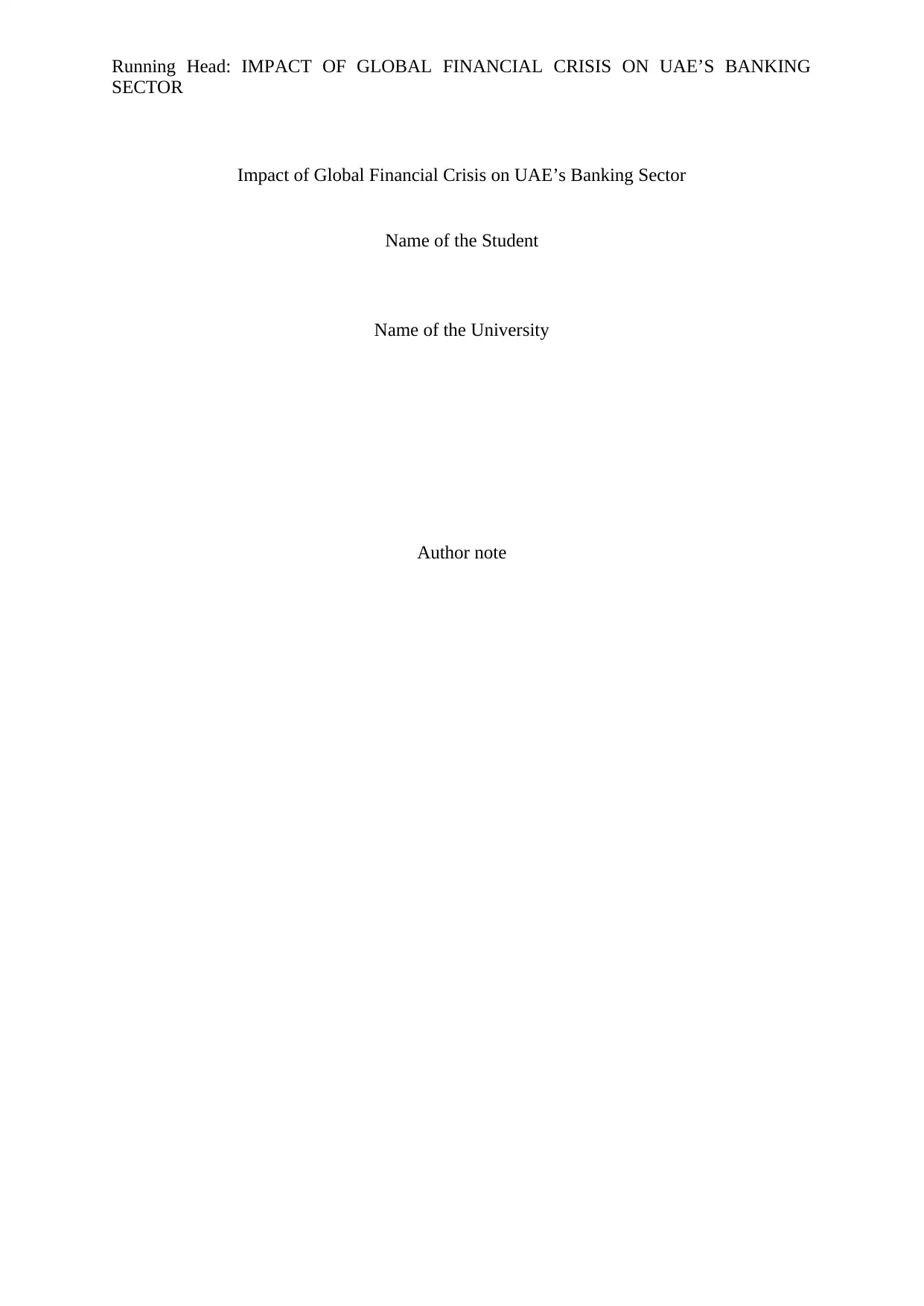
Running Head: IMPACT OF GLOBAL FINANCIAL CRISIS ON UAE’S BANKING
SECTOR
Impact of Global Financial Crisis on UAE’s Banking Sector
Name of the Student
Name of the University
Author note
SECTOR
Impact of Global Financial Crisis on UAE’s Banking Sector
Name of the Student
Name of the University
Author note
Paraphrase This Document
Need a fresh take? Get an instant paraphrase of this document with our AI Paraphraser
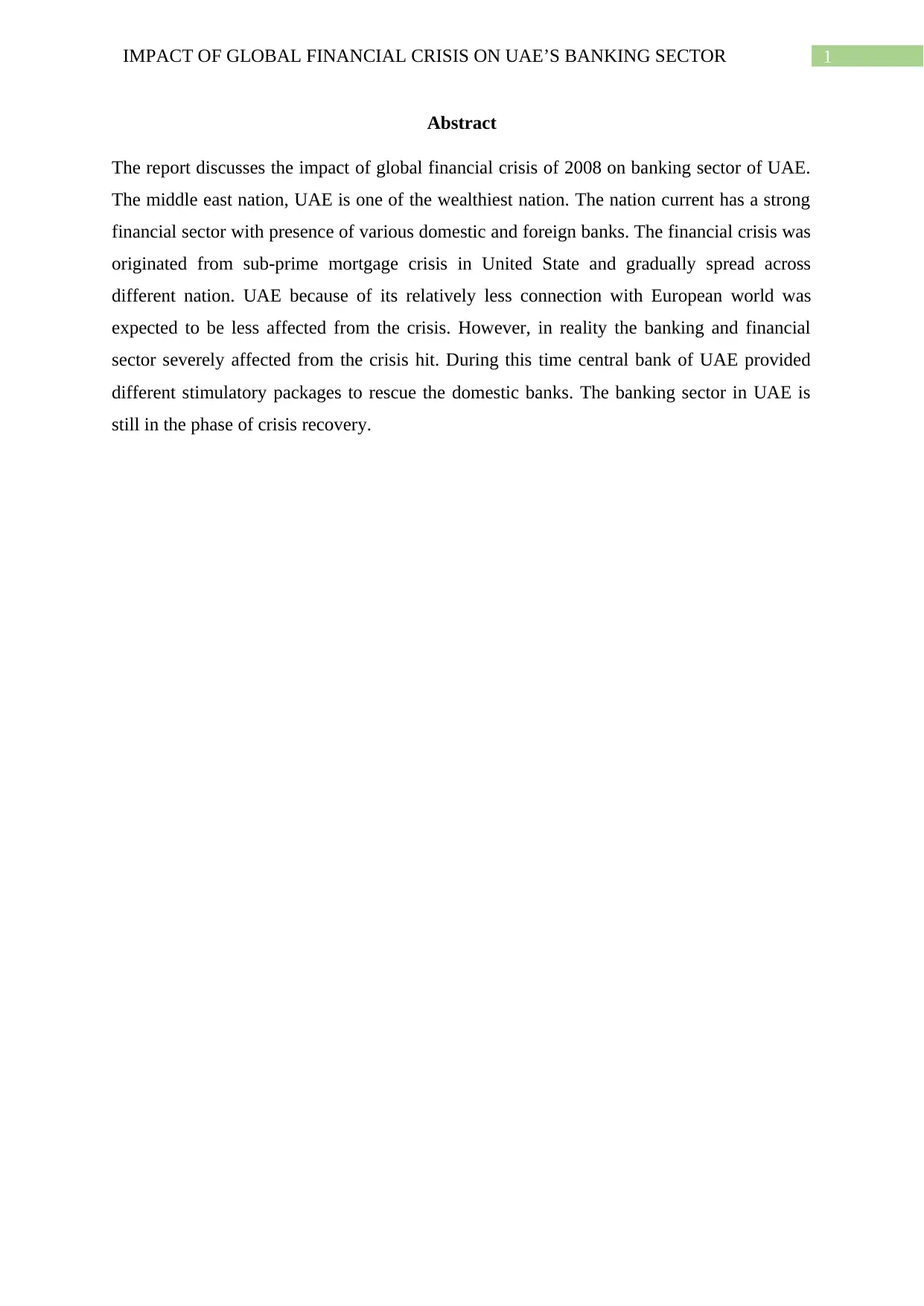
1IMPACT OF GLOBAL FINANCIAL CRISIS ON UAE’S BANKING SECTOR
Abstract
The report discusses the impact of global financial crisis of 2008 on banking sector of UAE.
The middle east nation, UAE is one of the wealthiest nation. The nation current has a strong
financial sector with presence of various domestic and foreign banks. The financial crisis was
originated from sub-prime mortgage crisis in United State and gradually spread across
different nation. UAE because of its relatively less connection with European world was
expected to be less affected from the crisis. However, in reality the banking and financial
sector severely affected from the crisis hit. During this time central bank of UAE provided
different stimulatory packages to rescue the domestic banks. The banking sector in UAE is
still in the phase of crisis recovery.
Abstract
The report discusses the impact of global financial crisis of 2008 on banking sector of UAE.
The middle east nation, UAE is one of the wealthiest nation. The nation current has a strong
financial sector with presence of various domestic and foreign banks. The financial crisis was
originated from sub-prime mortgage crisis in United State and gradually spread across
different nation. UAE because of its relatively less connection with European world was
expected to be less affected from the crisis. However, in reality the banking and financial
sector severely affected from the crisis hit. During this time central bank of UAE provided
different stimulatory packages to rescue the domestic banks. The banking sector in UAE is
still in the phase of crisis recovery.
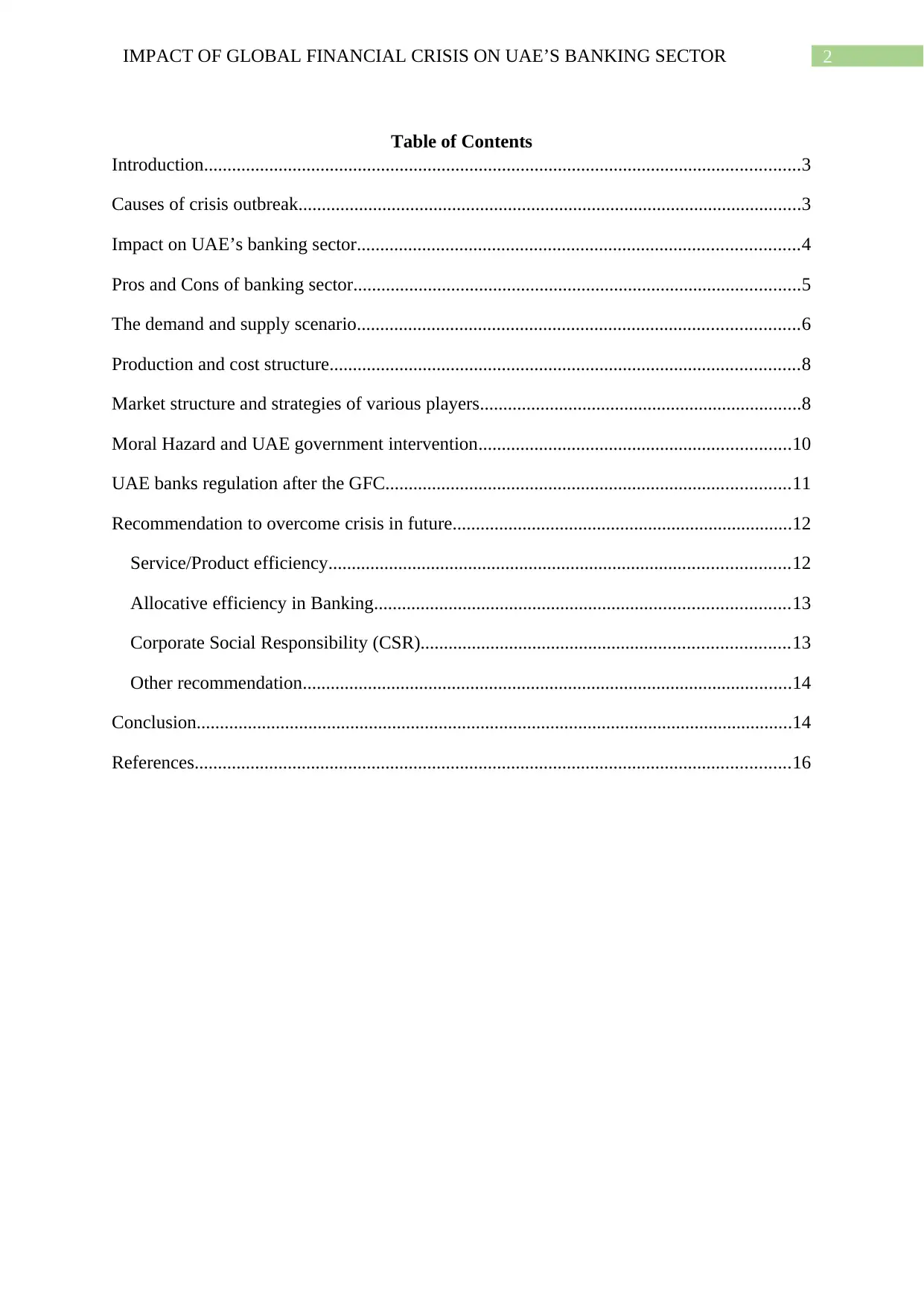
2IMPACT OF GLOBAL FINANCIAL CRISIS ON UAE’S BANKING SECTOR
Table of Contents
Introduction................................................................................................................................3
Causes of crisis outbreak............................................................................................................3
Impact on UAE’s banking sector...............................................................................................4
Pros and Cons of banking sector................................................................................................5
The demand and supply scenario...............................................................................................6
Production and cost structure.....................................................................................................8
Market structure and strategies of various players.....................................................................8
Moral Hazard and UAE government intervention...................................................................10
UAE banks regulation after the GFC.......................................................................................11
Recommendation to overcome crisis in future.........................................................................12
Service/Product efficiency...................................................................................................12
Allocative efficiency in Banking.........................................................................................13
Corporate Social Responsibility (CSR)...............................................................................13
Other recommendation.........................................................................................................14
Conclusion................................................................................................................................14
References................................................................................................................................16
Table of Contents
Introduction................................................................................................................................3
Causes of crisis outbreak............................................................................................................3
Impact on UAE’s banking sector...............................................................................................4
Pros and Cons of banking sector................................................................................................5
The demand and supply scenario...............................................................................................6
Production and cost structure.....................................................................................................8
Market structure and strategies of various players.....................................................................8
Moral Hazard and UAE government intervention...................................................................10
UAE banks regulation after the GFC.......................................................................................11
Recommendation to overcome crisis in future.........................................................................12
Service/Product efficiency...................................................................................................12
Allocative efficiency in Banking.........................................................................................13
Corporate Social Responsibility (CSR)...............................................................................13
Other recommendation.........................................................................................................14
Conclusion................................................................................................................................14
References................................................................................................................................16
⊘ This is a preview!⊘
Do you want full access?
Subscribe today to unlock all pages.

Trusted by 1+ million students worldwide
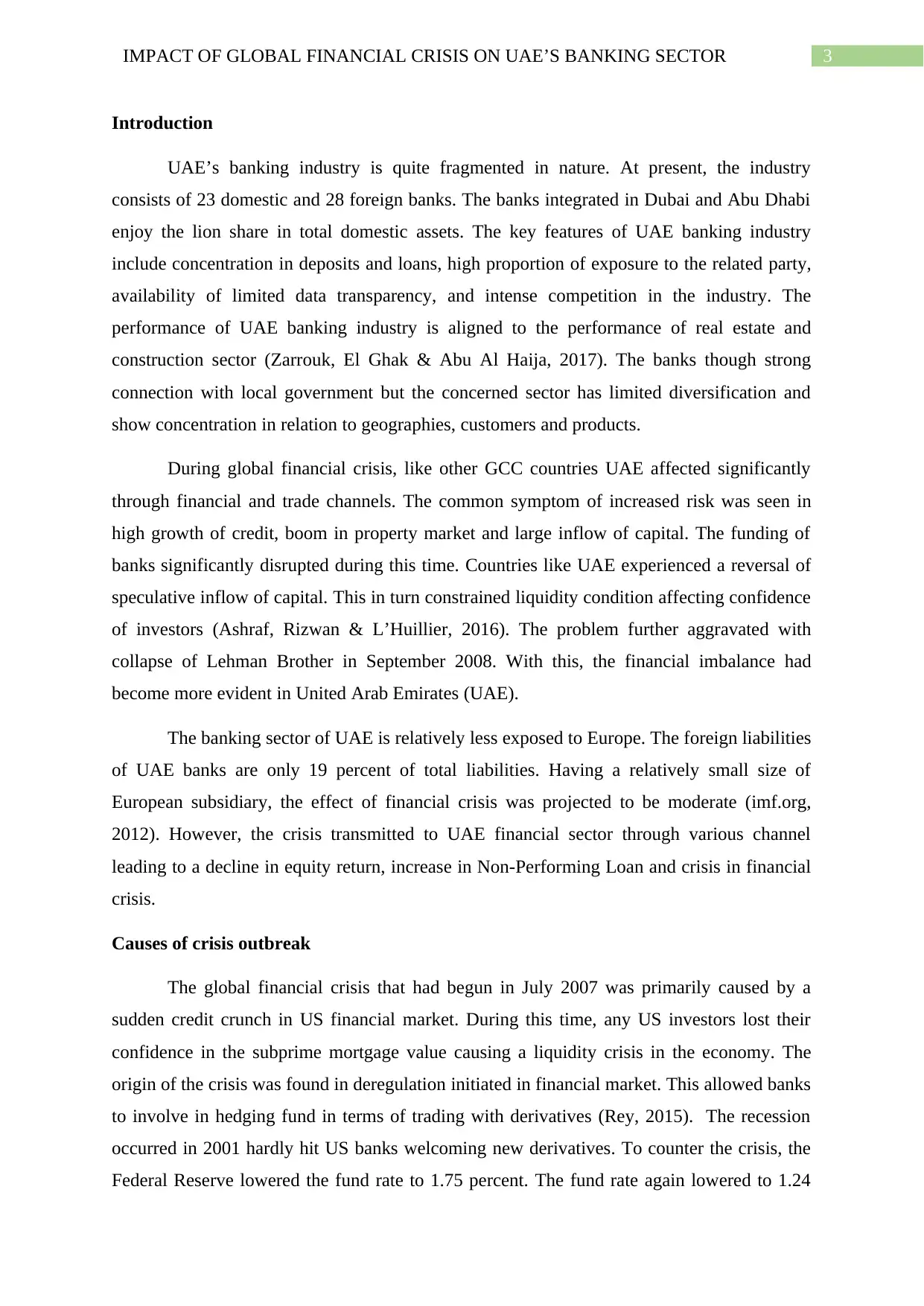
3IMPACT OF GLOBAL FINANCIAL CRISIS ON UAE’S BANKING SECTOR
Introduction
UAE’s banking industry is quite fragmented in nature. At present, the industry
consists of 23 domestic and 28 foreign banks. The banks integrated in Dubai and Abu Dhabi
enjoy the lion share in total domestic assets. The key features of UAE banking industry
include concentration in deposits and loans, high proportion of exposure to the related party,
availability of limited data transparency, and intense competition in the industry. The
performance of UAE banking industry is aligned to the performance of real estate and
construction sector (Zarrouk, El Ghak & Abu Al Haija, 2017). The banks though strong
connection with local government but the concerned sector has limited diversification and
show concentration in relation to geographies, customers and products.
During global financial crisis, like other GCC countries UAE affected significantly
through financial and trade channels. The common symptom of increased risk was seen in
high growth of credit, boom in property market and large inflow of capital. The funding of
banks significantly disrupted during this time. Countries like UAE experienced a reversal of
speculative inflow of capital. This in turn constrained liquidity condition affecting confidence
of investors (Ashraf, Rizwan & L’Huillier, 2016). The problem further aggravated with
collapse of Lehman Brother in September 2008. With this, the financial imbalance had
become more evident in United Arab Emirates (UAE).
The banking sector of UAE is relatively less exposed to Europe. The foreign liabilities
of UAE banks are only 19 percent of total liabilities. Having a relatively small size of
European subsidiary, the effect of financial crisis was projected to be moderate (imf.org,
2012). However, the crisis transmitted to UAE financial sector through various channel
leading to a decline in equity return, increase in Non-Performing Loan and crisis in financial
crisis.
Causes of crisis outbreak
The global financial crisis that had begun in July 2007 was primarily caused by a
sudden credit crunch in US financial market. During this time, any US investors lost their
confidence in the subprime mortgage value causing a liquidity crisis in the economy. The
origin of the crisis was found in deregulation initiated in financial market. This allowed banks
to involve in hedging fund in terms of trading with derivatives (Rey, 2015). The recession
occurred in 2001 hardly hit US banks welcoming new derivatives. To counter the crisis, the
Federal Reserve lowered the fund rate to 1.75 percent. The fund rate again lowered to 1.24
Introduction
UAE’s banking industry is quite fragmented in nature. At present, the industry
consists of 23 domestic and 28 foreign banks. The banks integrated in Dubai and Abu Dhabi
enjoy the lion share in total domestic assets. The key features of UAE banking industry
include concentration in deposits and loans, high proportion of exposure to the related party,
availability of limited data transparency, and intense competition in the industry. The
performance of UAE banking industry is aligned to the performance of real estate and
construction sector (Zarrouk, El Ghak & Abu Al Haija, 2017). The banks though strong
connection with local government but the concerned sector has limited diversification and
show concentration in relation to geographies, customers and products.
During global financial crisis, like other GCC countries UAE affected significantly
through financial and trade channels. The common symptom of increased risk was seen in
high growth of credit, boom in property market and large inflow of capital. The funding of
banks significantly disrupted during this time. Countries like UAE experienced a reversal of
speculative inflow of capital. This in turn constrained liquidity condition affecting confidence
of investors (Ashraf, Rizwan & L’Huillier, 2016). The problem further aggravated with
collapse of Lehman Brother in September 2008. With this, the financial imbalance had
become more evident in United Arab Emirates (UAE).
The banking sector of UAE is relatively less exposed to Europe. The foreign liabilities
of UAE banks are only 19 percent of total liabilities. Having a relatively small size of
European subsidiary, the effect of financial crisis was projected to be moderate (imf.org,
2012). However, the crisis transmitted to UAE financial sector through various channel
leading to a decline in equity return, increase in Non-Performing Loan and crisis in financial
crisis.
Causes of crisis outbreak
The global financial crisis that had begun in July 2007 was primarily caused by a
sudden credit crunch in US financial market. During this time, any US investors lost their
confidence in the subprime mortgage value causing a liquidity crisis in the economy. The
origin of the crisis was found in deregulation initiated in financial market. This allowed banks
to involve in hedging fund in terms of trading with derivatives (Rey, 2015). The recession
occurred in 2001 hardly hit US banks welcoming new derivatives. To counter the crisis, the
Federal Reserve lowered the fund rate to 1.75 percent. The fund rate again lowered to 1.24
Paraphrase This Document
Need a fresh take? Get an instant paraphrase of this document with our AI Paraphraser
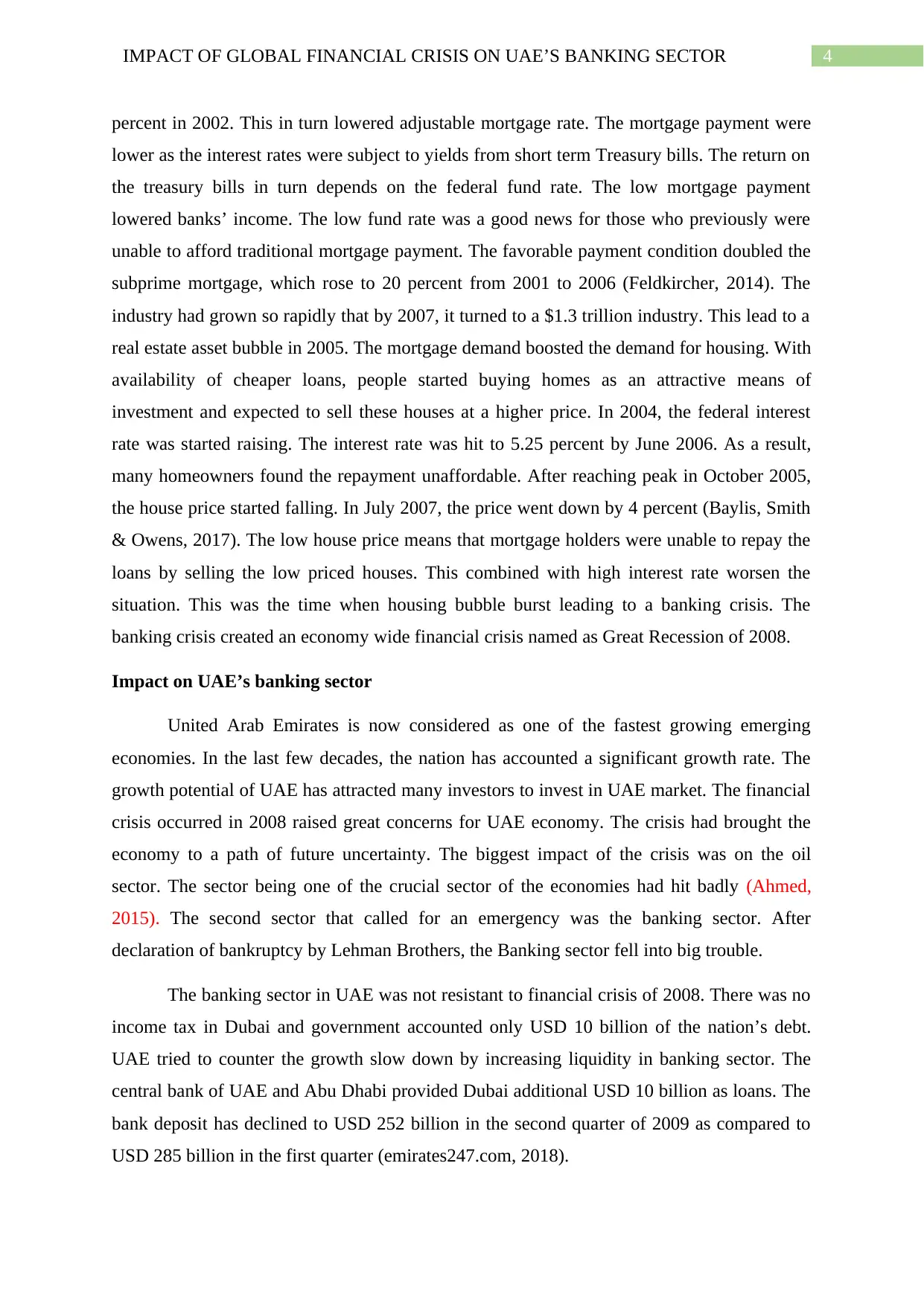
4IMPACT OF GLOBAL FINANCIAL CRISIS ON UAE’S BANKING SECTOR
percent in 2002. This in turn lowered adjustable mortgage rate. The mortgage payment were
lower as the interest rates were subject to yields from short term Treasury bills. The return on
the treasury bills in turn depends on the federal fund rate. The low mortgage payment
lowered banks’ income. The low fund rate was a good news for those who previously were
unable to afford traditional mortgage payment. The favorable payment condition doubled the
subprime mortgage, which rose to 20 percent from 2001 to 2006 (Feldkircher, 2014). The
industry had grown so rapidly that by 2007, it turned to a $1.3 trillion industry. This lead to a
real estate asset bubble in 2005. The mortgage demand boosted the demand for housing. With
availability of cheaper loans, people started buying homes as an attractive means of
investment and expected to sell these houses at a higher price. In 2004, the federal interest
rate was started raising. The interest rate was hit to 5.25 percent by June 2006. As a result,
many homeowners found the repayment unaffordable. After reaching peak in October 2005,
the house price started falling. In July 2007, the price went down by 4 percent (Baylis, Smith
& Owens, 2017). The low house price means that mortgage holders were unable to repay the
loans by selling the low priced houses. This combined with high interest rate worsen the
situation. This was the time when housing bubble burst leading to a banking crisis. The
banking crisis created an economy wide financial crisis named as Great Recession of 2008.
Impact on UAE’s banking sector
United Arab Emirates is now considered as one of the fastest growing emerging
economies. In the last few decades, the nation has accounted a significant growth rate. The
growth potential of UAE has attracted many investors to invest in UAE market. The financial
crisis occurred in 2008 raised great concerns for UAE economy. The crisis had brought the
economy to a path of future uncertainty. The biggest impact of the crisis was on the oil
sector. The sector being one of the crucial sector of the economies had hit badly (Ahmed,
2015). The second sector that called for an emergency was the banking sector. After
declaration of bankruptcy by Lehman Brothers, the Banking sector fell into big trouble.
The banking sector in UAE was not resistant to financial crisis of 2008. There was no
income tax in Dubai and government accounted only USD 10 billion of the nation’s debt.
UAE tried to counter the growth slow down by increasing liquidity in banking sector. The
central bank of UAE and Abu Dhabi provided Dubai additional USD 10 billion as loans. The
bank deposit has declined to USD 252 billion in the second quarter of 2009 as compared to
USD 285 billion in the first quarter (emirates247.com, 2018).
percent in 2002. This in turn lowered adjustable mortgage rate. The mortgage payment were
lower as the interest rates were subject to yields from short term Treasury bills. The return on
the treasury bills in turn depends on the federal fund rate. The low mortgage payment
lowered banks’ income. The low fund rate was a good news for those who previously were
unable to afford traditional mortgage payment. The favorable payment condition doubled the
subprime mortgage, which rose to 20 percent from 2001 to 2006 (Feldkircher, 2014). The
industry had grown so rapidly that by 2007, it turned to a $1.3 trillion industry. This lead to a
real estate asset bubble in 2005. The mortgage demand boosted the demand for housing. With
availability of cheaper loans, people started buying homes as an attractive means of
investment and expected to sell these houses at a higher price. In 2004, the federal interest
rate was started raising. The interest rate was hit to 5.25 percent by June 2006. As a result,
many homeowners found the repayment unaffordable. After reaching peak in October 2005,
the house price started falling. In July 2007, the price went down by 4 percent (Baylis, Smith
& Owens, 2017). The low house price means that mortgage holders were unable to repay the
loans by selling the low priced houses. This combined with high interest rate worsen the
situation. This was the time when housing bubble burst leading to a banking crisis. The
banking crisis created an economy wide financial crisis named as Great Recession of 2008.
Impact on UAE’s banking sector
United Arab Emirates is now considered as one of the fastest growing emerging
economies. In the last few decades, the nation has accounted a significant growth rate. The
growth potential of UAE has attracted many investors to invest in UAE market. The financial
crisis occurred in 2008 raised great concerns for UAE economy. The crisis had brought the
economy to a path of future uncertainty. The biggest impact of the crisis was on the oil
sector. The sector being one of the crucial sector of the economies had hit badly (Ahmed,
2015). The second sector that called for an emergency was the banking sector. After
declaration of bankruptcy by Lehman Brothers, the Banking sector fell into big trouble.
The banking sector in UAE was not resistant to financial crisis of 2008. There was no
income tax in Dubai and government accounted only USD 10 billion of the nation’s debt.
UAE tried to counter the growth slow down by increasing liquidity in banking sector. The
central bank of UAE and Abu Dhabi provided Dubai additional USD 10 billion as loans. The
bank deposit has declined to USD 252 billion in the second quarter of 2009 as compared to
USD 285 billion in the first quarter (emirates247.com, 2018).

5IMPACT OF GLOBAL FINANCIAL CRISIS ON UAE’S BANKING SECTOR
The bank shares in UAE had slammed by a historical fall in oil prices. The loan to
deposit ratio fell to 108 percent in 2008. During this time, the coverage ratio also fell
significantly. The banking sector of UAE was relied on wholesale global funding market. The
global funding market was frozen after failure of Lehman’s Brother and this hurt the
confidence of international interbank market. Following the crisis hit, many depositors run
out from Gulf Banks. The Saad/Al Gosaibi bank loan scandal of $24 billion hurt confidence
of banks. The bailout of US’s Treasury, AIG, RBS and Lloyds all contributed to an increase
in risk premium for borrowers (Singh et al., 2017). This made borrowers nervous and
unsettled in the financial market.
The lost confidence of banking sector had a direct impact on employees. Banks in
order to reduce their employee expenses laid off many workers. HSBC for example had
served termination notice to many junior and middle management employees. During 2009,
HSBC had experienced a 35 percent decline in H1 pre-tax profit to the $643 million as
compared to the pre-tax profit in 2008 (arabianbusiness.com, 2018). The charges for loan
impairment had increased sharply to $391 million from earlier $41 million following
deterioration of credit quality due to weak economic condition.
Pros and Cons of banking sector
The integration of UAE with global financial market makes the nation extremely
vulnerable to financial crisis in 2008. The banking sector of UAE is highly capitalized. The
blue chip investment has made UAE an important participant in international capital market.
The UAE banking sector is not only well capitalized but also the sector is highly profitable
with support of banks’ asset base. During 2017, the profit of banks rose sharply. In 2008, the
capital adequacy ratio was 13.3 percent exceeding the minimum limit of 10 percent (Rosman,
Wahab & Zainol, 2014). During 2008 financial crisis, the growth and profitability of UAE
banking sector was severely interrupted. The global financial crisis of 2008 reduced the
availability of wholesale funding. This hampered the flow of fund in to the banking sector.
Extreme pressure on portfolio investment, shuttered real estate market, withdrawal of loan
agreement from real estate projects all affected the performance of banking sector.
The economy had plenty of credit flow in the first half of 2008. However, the
financial condition became tightened in the second half of 2008. There were three key factors
that contribute to a sudden drop in the financial performance of UAE following global
financial crisis. After financial crisis, it became difficult and costly to access to global capital
The bank shares in UAE had slammed by a historical fall in oil prices. The loan to
deposit ratio fell to 108 percent in 2008. During this time, the coverage ratio also fell
significantly. The banking sector of UAE was relied on wholesale global funding market. The
global funding market was frozen after failure of Lehman’s Brother and this hurt the
confidence of international interbank market. Following the crisis hit, many depositors run
out from Gulf Banks. The Saad/Al Gosaibi bank loan scandal of $24 billion hurt confidence
of banks. The bailout of US’s Treasury, AIG, RBS and Lloyds all contributed to an increase
in risk premium for borrowers (Singh et al., 2017). This made borrowers nervous and
unsettled in the financial market.
The lost confidence of banking sector had a direct impact on employees. Banks in
order to reduce their employee expenses laid off many workers. HSBC for example had
served termination notice to many junior and middle management employees. During 2009,
HSBC had experienced a 35 percent decline in H1 pre-tax profit to the $643 million as
compared to the pre-tax profit in 2008 (arabianbusiness.com, 2018). The charges for loan
impairment had increased sharply to $391 million from earlier $41 million following
deterioration of credit quality due to weak economic condition.
Pros and Cons of banking sector
The integration of UAE with global financial market makes the nation extremely
vulnerable to financial crisis in 2008. The banking sector of UAE is highly capitalized. The
blue chip investment has made UAE an important participant in international capital market.
The UAE banking sector is not only well capitalized but also the sector is highly profitable
with support of banks’ asset base. During 2017, the profit of banks rose sharply. In 2008, the
capital adequacy ratio was 13.3 percent exceeding the minimum limit of 10 percent (Rosman,
Wahab & Zainol, 2014). During 2008 financial crisis, the growth and profitability of UAE
banking sector was severely interrupted. The global financial crisis of 2008 reduced the
availability of wholesale funding. This hampered the flow of fund in to the banking sector.
Extreme pressure on portfolio investment, shuttered real estate market, withdrawal of loan
agreement from real estate projects all affected the performance of banking sector.
The economy had plenty of credit flow in the first half of 2008. However, the
financial condition became tightened in the second half of 2008. There were three key factors
that contribute to a sudden drop in the financial performance of UAE following global
financial crisis. After financial crisis, it became difficult and costly to access to global capital
⊘ This is a preview!⊘
Do you want full access?
Subscribe today to unlock all pages.

Trusted by 1+ million students worldwide
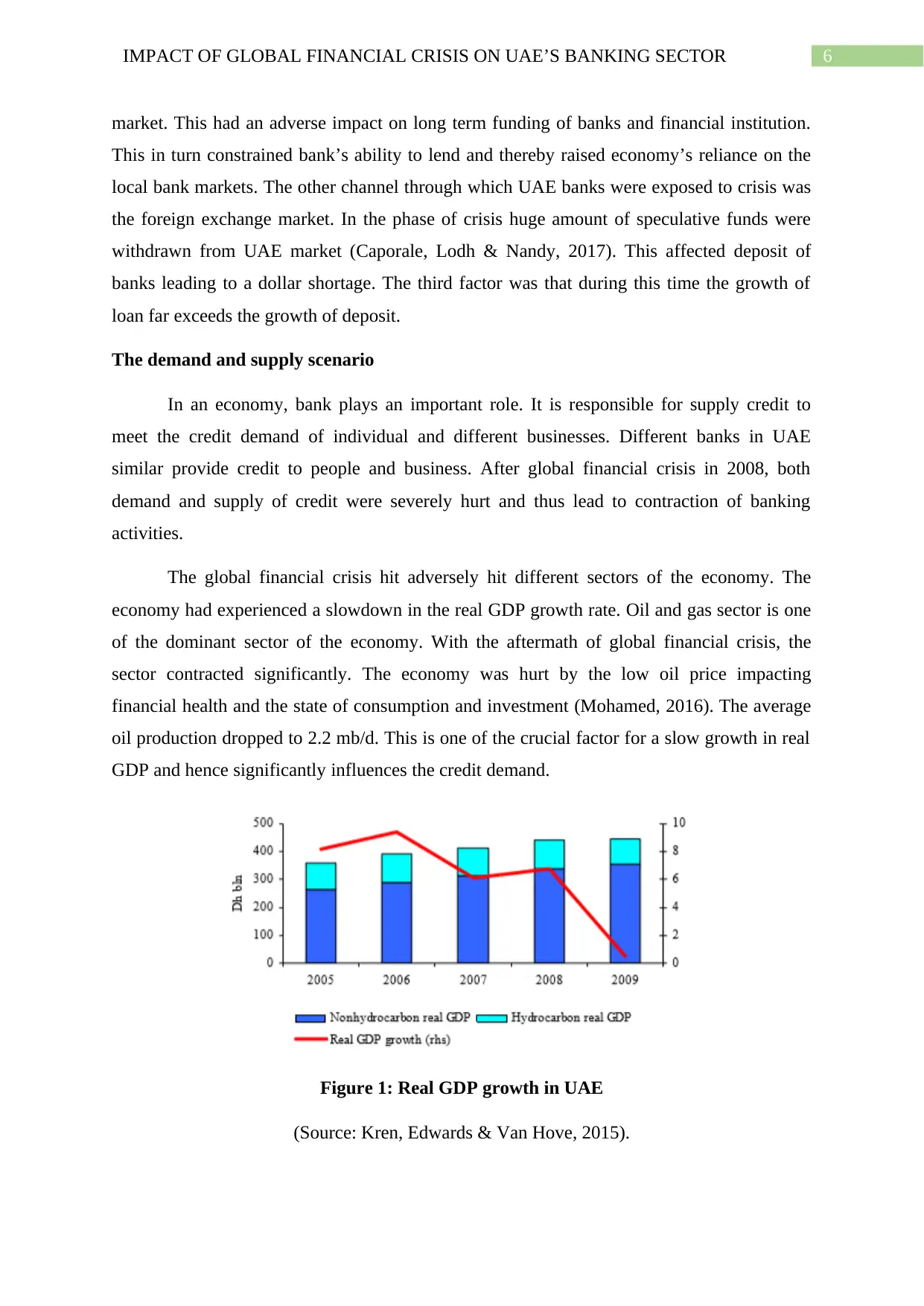
6IMPACT OF GLOBAL FINANCIAL CRISIS ON UAE’S BANKING SECTOR
market. This had an adverse impact on long term funding of banks and financial institution.
This in turn constrained bank’s ability to lend and thereby raised economy’s reliance on the
local bank markets. The other channel through which UAE banks were exposed to crisis was
the foreign exchange market. In the phase of crisis huge amount of speculative funds were
withdrawn from UAE market (Caporale, Lodh & Nandy, 2017). This affected deposit of
banks leading to a dollar shortage. The third factor was that during this time the growth of
loan far exceeds the growth of deposit.
The demand and supply scenario
In an economy, bank plays an important role. It is responsible for supply credit to
meet the credit demand of individual and different businesses. Different banks in UAE
similar provide credit to people and business. After global financial crisis in 2008, both
demand and supply of credit were severely hurt and thus lead to contraction of banking
activities.
The global financial crisis hit adversely hit different sectors of the economy. The
economy had experienced a slowdown in the real GDP growth rate. Oil and gas sector is one
of the dominant sector of the economy. With the aftermath of global financial crisis, the
sector contracted significantly. The economy was hurt by the low oil price impacting
financial health and the state of consumption and investment (Mohamed, 2016). The average
oil production dropped to 2.2 mb/d. This is one of the crucial factor for a slow growth in real
GDP and hence significantly influences the credit demand.
Figure 1: Real GDP growth in UAE
(Source: Kren, Edwards & Van Hove, 2015).
market. This had an adverse impact on long term funding of banks and financial institution.
This in turn constrained bank’s ability to lend and thereby raised economy’s reliance on the
local bank markets. The other channel through which UAE banks were exposed to crisis was
the foreign exchange market. In the phase of crisis huge amount of speculative funds were
withdrawn from UAE market (Caporale, Lodh & Nandy, 2017). This affected deposit of
banks leading to a dollar shortage. The third factor was that during this time the growth of
loan far exceeds the growth of deposit.
The demand and supply scenario
In an economy, bank plays an important role. It is responsible for supply credit to
meet the credit demand of individual and different businesses. Different banks in UAE
similar provide credit to people and business. After global financial crisis in 2008, both
demand and supply of credit were severely hurt and thus lead to contraction of banking
activities.
The global financial crisis hit adversely hit different sectors of the economy. The
economy had experienced a slowdown in the real GDP growth rate. Oil and gas sector is one
of the dominant sector of the economy. With the aftermath of global financial crisis, the
sector contracted significantly. The economy was hurt by the low oil price impacting
financial health and the state of consumption and investment (Mohamed, 2016). The average
oil production dropped to 2.2 mb/d. This is one of the crucial factor for a slow growth in real
GDP and hence significantly influences the credit demand.
Figure 1: Real GDP growth in UAE
(Source: Kren, Edwards & Van Hove, 2015).
Paraphrase This Document
Need a fresh take? Get an instant paraphrase of this document with our AI Paraphraser
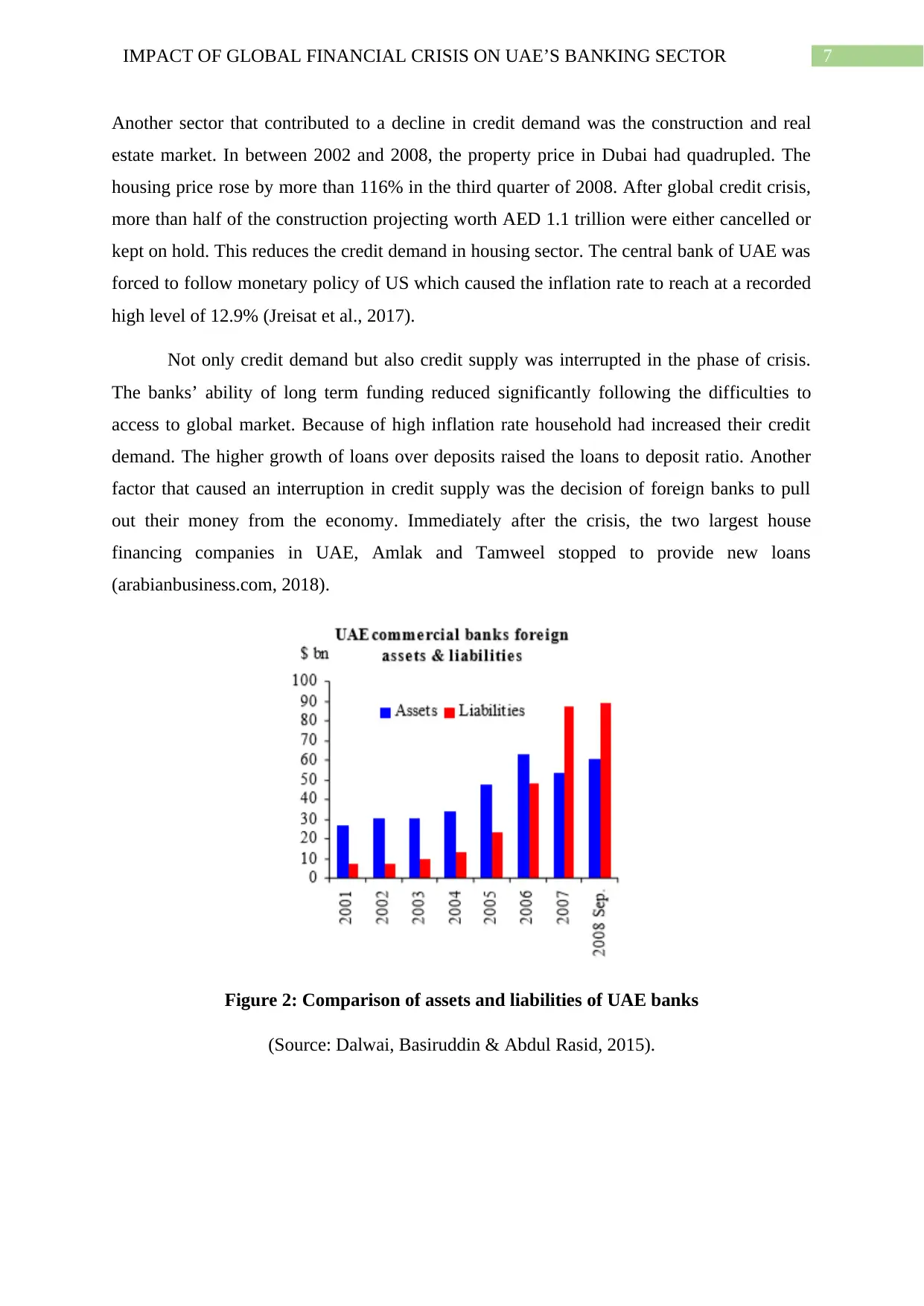
7IMPACT OF GLOBAL FINANCIAL CRISIS ON UAE’S BANKING SECTOR
Another sector that contributed to a decline in credit demand was the construction and real
estate market. In between 2002 and 2008, the property price in Dubai had quadrupled. The
housing price rose by more than 116% in the third quarter of 2008. After global credit crisis,
more than half of the construction projecting worth AED 1.1 trillion were either cancelled or
kept on hold. This reduces the credit demand in housing sector. The central bank of UAE was
forced to follow monetary policy of US which caused the inflation rate to reach at a recorded
high level of 12.9% (Jreisat et al., 2017).
Not only credit demand but also credit supply was interrupted in the phase of crisis.
The banks’ ability of long term funding reduced significantly following the difficulties to
access to global market. Because of high inflation rate household had increased their credit
demand. The higher growth of loans over deposits raised the loans to deposit ratio. Another
factor that caused an interruption in credit supply was the decision of foreign banks to pull
out their money from the economy. Immediately after the crisis, the two largest house
financing companies in UAE, Amlak and Tamweel stopped to provide new loans
(arabianbusiness.com, 2018).
Figure 2: Comparison of assets and liabilities of UAE banks
(Source: Dalwai, Basiruddin & Abdul Rasid, 2015).
Another sector that contributed to a decline in credit demand was the construction and real
estate market. In between 2002 and 2008, the property price in Dubai had quadrupled. The
housing price rose by more than 116% in the third quarter of 2008. After global credit crisis,
more than half of the construction projecting worth AED 1.1 trillion were either cancelled or
kept on hold. This reduces the credit demand in housing sector. The central bank of UAE was
forced to follow monetary policy of US which caused the inflation rate to reach at a recorded
high level of 12.9% (Jreisat et al., 2017).
Not only credit demand but also credit supply was interrupted in the phase of crisis.
The banks’ ability of long term funding reduced significantly following the difficulties to
access to global market. Because of high inflation rate household had increased their credit
demand. The higher growth of loans over deposits raised the loans to deposit ratio. Another
factor that caused an interruption in credit supply was the decision of foreign banks to pull
out their money from the economy. Immediately after the crisis, the two largest house
financing companies in UAE, Amlak and Tamweel stopped to provide new loans
(arabianbusiness.com, 2018).
Figure 2: Comparison of assets and liabilities of UAE banks
(Source: Dalwai, Basiruddin & Abdul Rasid, 2015).
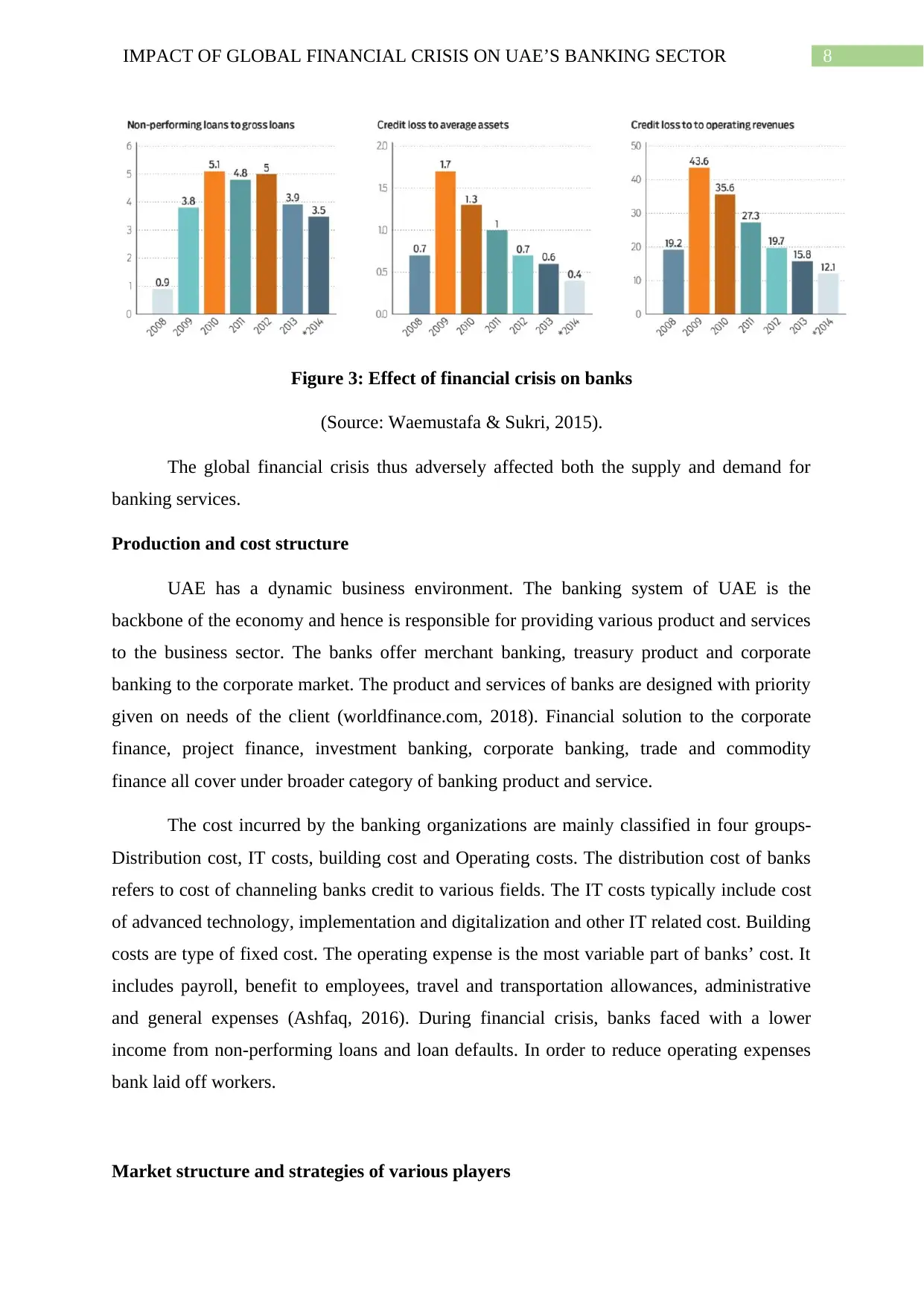
8IMPACT OF GLOBAL FINANCIAL CRISIS ON UAE’S BANKING SECTOR
Figure 3: Effect of financial crisis on banks
(Source: Waemustafa & Sukri, 2015).
The global financial crisis thus adversely affected both the supply and demand for
banking services.
Production and cost structure
UAE has a dynamic business environment. The banking system of UAE is the
backbone of the economy and hence is responsible for providing various product and services
to the business sector. The banks offer merchant banking, treasury product and corporate
banking to the corporate market. The product and services of banks are designed with priority
given on needs of the client (worldfinance.com, 2018). Financial solution to the corporate
finance, project finance, investment banking, corporate banking, trade and commodity
finance all cover under broader category of banking product and service.
The cost incurred by the banking organizations are mainly classified in four groups-
Distribution cost, IT costs, building cost and Operating costs. The distribution cost of banks
refers to cost of channeling banks credit to various fields. The IT costs typically include cost
of advanced technology, implementation and digitalization and other IT related cost. Building
costs are type of fixed cost. The operating expense is the most variable part of banks’ cost. It
includes payroll, benefit to employees, travel and transportation allowances, administrative
and general expenses (Ashfaq, 2016). During financial crisis, banks faced with a lower
income from non-performing loans and loan defaults. In order to reduce operating expenses
bank laid off workers.
Market structure and strategies of various players
Figure 3: Effect of financial crisis on banks
(Source: Waemustafa & Sukri, 2015).
The global financial crisis thus adversely affected both the supply and demand for
banking services.
Production and cost structure
UAE has a dynamic business environment. The banking system of UAE is the
backbone of the economy and hence is responsible for providing various product and services
to the business sector. The banks offer merchant banking, treasury product and corporate
banking to the corporate market. The product and services of banks are designed with priority
given on needs of the client (worldfinance.com, 2018). Financial solution to the corporate
finance, project finance, investment banking, corporate banking, trade and commodity
finance all cover under broader category of banking product and service.
The cost incurred by the banking organizations are mainly classified in four groups-
Distribution cost, IT costs, building cost and Operating costs. The distribution cost of banks
refers to cost of channeling banks credit to various fields. The IT costs typically include cost
of advanced technology, implementation and digitalization and other IT related cost. Building
costs are type of fixed cost. The operating expense is the most variable part of banks’ cost. It
includes payroll, benefit to employees, travel and transportation allowances, administrative
and general expenses (Ashfaq, 2016). During financial crisis, banks faced with a lower
income from non-performing loans and loan defaults. In order to reduce operating expenses
bank laid off workers.
Market structure and strategies of various players
⊘ This is a preview!⊘
Do you want full access?
Subscribe today to unlock all pages.

Trusted by 1+ million students worldwide
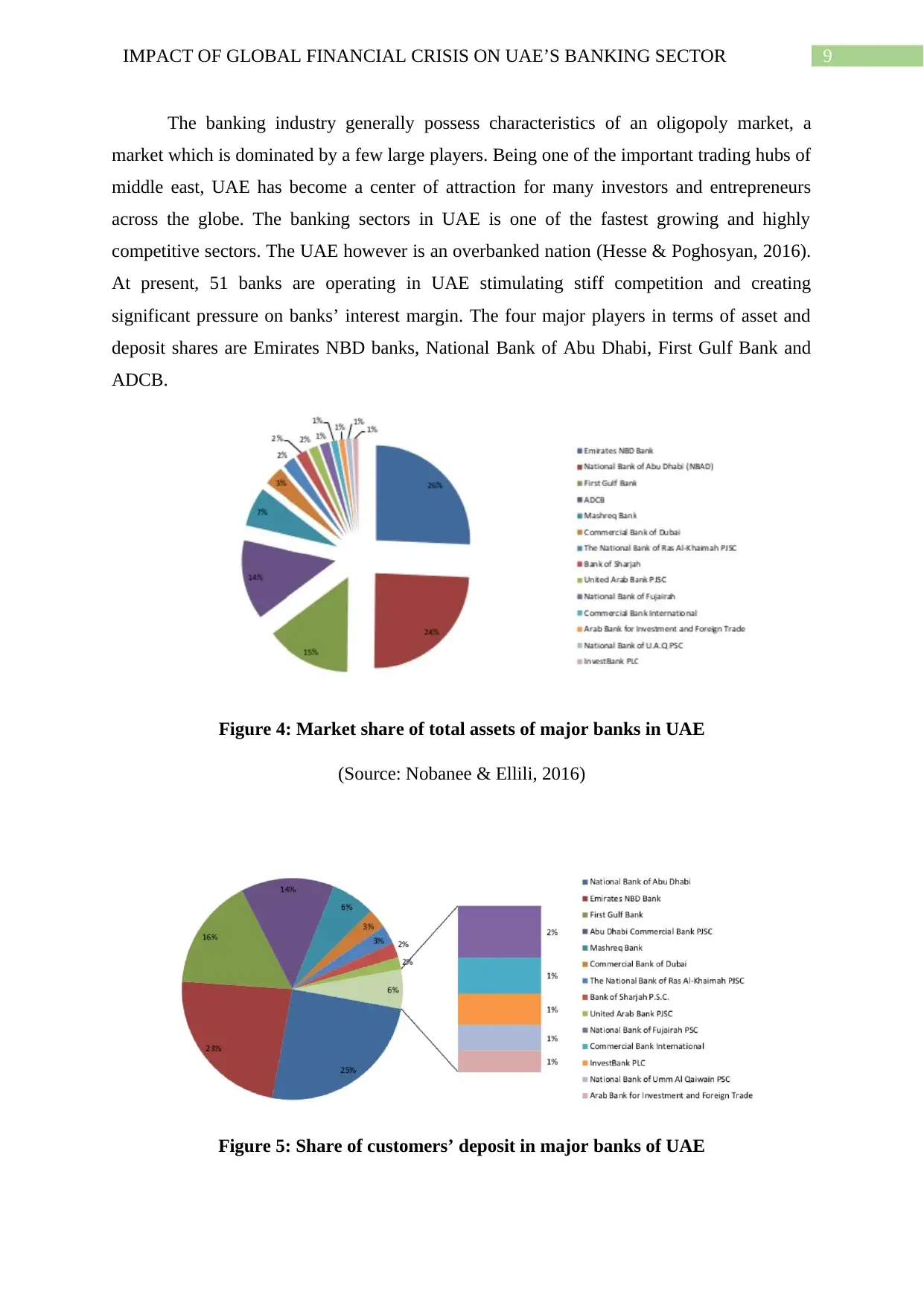
9IMPACT OF GLOBAL FINANCIAL CRISIS ON UAE’S BANKING SECTOR
The banking industry generally possess characteristics of an oligopoly market, a
market which is dominated by a few large players. Being one of the important trading hubs of
middle east, UAE has become a center of attraction for many investors and entrepreneurs
across the globe. The banking sectors in UAE is one of the fastest growing and highly
competitive sectors. The UAE however is an overbanked nation (Hesse & Poghosyan, 2016).
At present, 51 banks are operating in UAE stimulating stiff competition and creating
significant pressure on banks’ interest margin. The four major players in terms of asset and
deposit shares are Emirates NBD banks, National Bank of Abu Dhabi, First Gulf Bank and
ADCB.
Figure 4: Market share of total assets of major banks in UAE
(Source: Nobanee & Ellili, 2016)
Figure 5: Share of customers’ deposit in major banks of UAE
The banking industry generally possess characteristics of an oligopoly market, a
market which is dominated by a few large players. Being one of the important trading hubs of
middle east, UAE has become a center of attraction for many investors and entrepreneurs
across the globe. The banking sectors in UAE is one of the fastest growing and highly
competitive sectors. The UAE however is an overbanked nation (Hesse & Poghosyan, 2016).
At present, 51 banks are operating in UAE stimulating stiff competition and creating
significant pressure on banks’ interest margin. The four major players in terms of asset and
deposit shares are Emirates NBD banks, National Bank of Abu Dhabi, First Gulf Bank and
ADCB.
Figure 4: Market share of total assets of major banks in UAE
(Source: Nobanee & Ellili, 2016)
Figure 5: Share of customers’ deposit in major banks of UAE
Paraphrase This Document
Need a fresh take? Get an instant paraphrase of this document with our AI Paraphraser
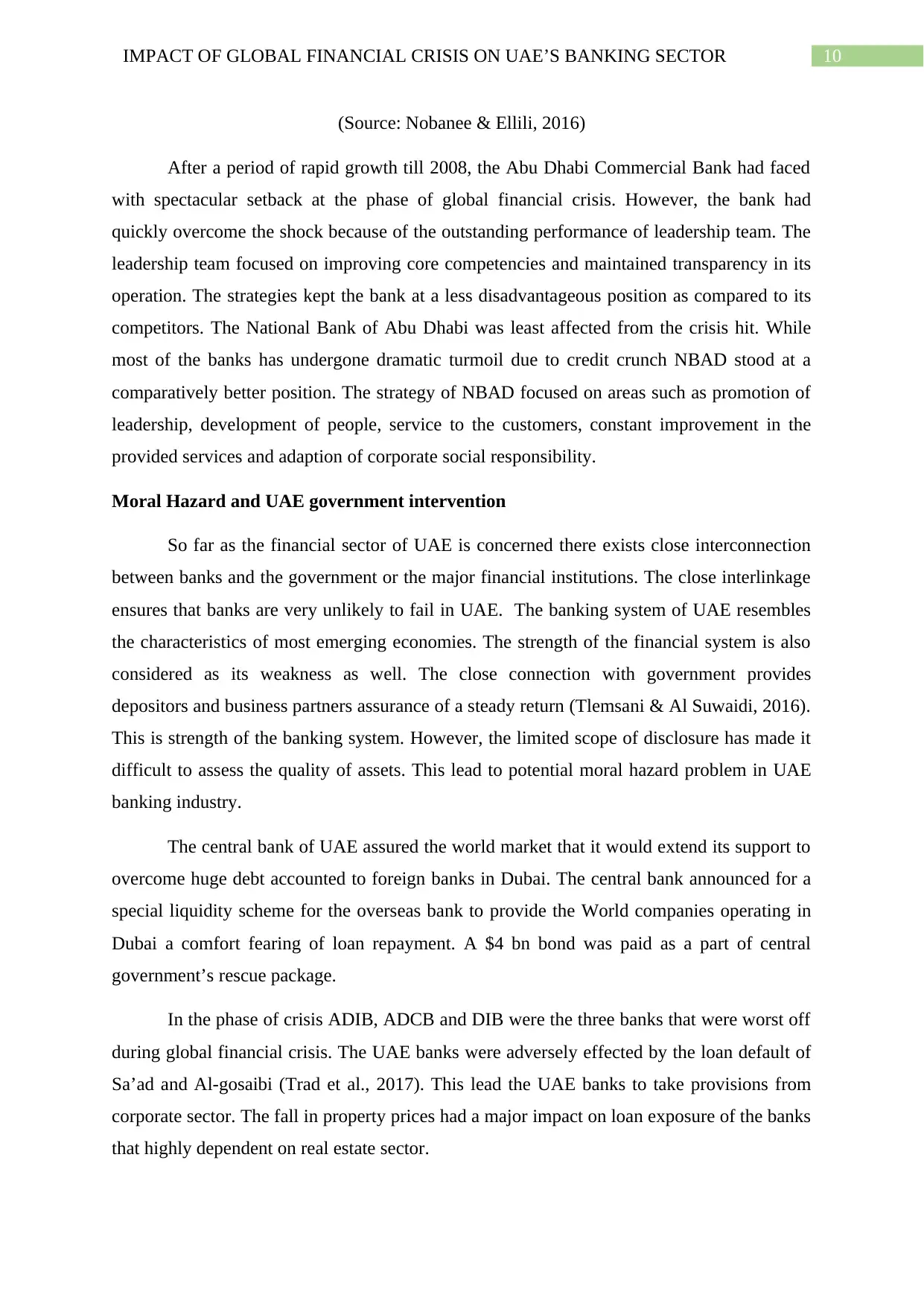
10IMPACT OF GLOBAL FINANCIAL CRISIS ON UAE’S BANKING SECTOR
(Source: Nobanee & Ellili, 2016)
After a period of rapid growth till 2008, the Abu Dhabi Commercial Bank had faced
with spectacular setback at the phase of global financial crisis. However, the bank had
quickly overcome the shock because of the outstanding performance of leadership team. The
leadership team focused on improving core competencies and maintained transparency in its
operation. The strategies kept the bank at a less disadvantageous position as compared to its
competitors. The National Bank of Abu Dhabi was least affected from the crisis hit. While
most of the banks has undergone dramatic turmoil due to credit crunch NBAD stood at a
comparatively better position. The strategy of NBAD focused on areas such as promotion of
leadership, development of people, service to the customers, constant improvement in the
provided services and adaption of corporate social responsibility.
Moral Hazard and UAE government intervention
So far as the financial sector of UAE is concerned there exists close interconnection
between banks and the government or the major financial institutions. The close interlinkage
ensures that banks are very unlikely to fail in UAE. The banking system of UAE resembles
the characteristics of most emerging economies. The strength of the financial system is also
considered as its weakness as well. The close connection with government provides
depositors and business partners assurance of a steady return (Tlemsani & Al Suwaidi, 2016).
This is strength of the banking system. However, the limited scope of disclosure has made it
difficult to assess the quality of assets. This lead to potential moral hazard problem in UAE
banking industry.
The central bank of UAE assured the world market that it would extend its support to
overcome huge debt accounted to foreign banks in Dubai. The central bank announced for a
special liquidity scheme for the overseas bank to provide the World companies operating in
Dubai a comfort fearing of loan repayment. A $4 bn bond was paid as a part of central
government’s rescue package.
In the phase of crisis ADIB, ADCB and DIB were the three banks that were worst off
during global financial crisis. The UAE banks were adversely effected by the loan default of
Sa’ad and Al-gosaibi (Trad et al., 2017). This lead the UAE banks to take provisions from
corporate sector. The fall in property prices had a major impact on loan exposure of the banks
that highly dependent on real estate sector.
(Source: Nobanee & Ellili, 2016)
After a period of rapid growth till 2008, the Abu Dhabi Commercial Bank had faced
with spectacular setback at the phase of global financial crisis. However, the bank had
quickly overcome the shock because of the outstanding performance of leadership team. The
leadership team focused on improving core competencies and maintained transparency in its
operation. The strategies kept the bank at a less disadvantageous position as compared to its
competitors. The National Bank of Abu Dhabi was least affected from the crisis hit. While
most of the banks has undergone dramatic turmoil due to credit crunch NBAD stood at a
comparatively better position. The strategy of NBAD focused on areas such as promotion of
leadership, development of people, service to the customers, constant improvement in the
provided services and adaption of corporate social responsibility.
Moral Hazard and UAE government intervention
So far as the financial sector of UAE is concerned there exists close interconnection
between banks and the government or the major financial institutions. The close interlinkage
ensures that banks are very unlikely to fail in UAE. The banking system of UAE resembles
the characteristics of most emerging economies. The strength of the financial system is also
considered as its weakness as well. The close connection with government provides
depositors and business partners assurance of a steady return (Tlemsani & Al Suwaidi, 2016).
This is strength of the banking system. However, the limited scope of disclosure has made it
difficult to assess the quality of assets. This lead to potential moral hazard problem in UAE
banking industry.
The central bank of UAE assured the world market that it would extend its support to
overcome huge debt accounted to foreign banks in Dubai. The central bank announced for a
special liquidity scheme for the overseas bank to provide the World companies operating in
Dubai a comfort fearing of loan repayment. A $4 bn bond was paid as a part of central
government’s rescue package.
In the phase of crisis ADIB, ADCB and DIB were the three banks that were worst off
during global financial crisis. The UAE banks were adversely effected by the loan default of
Sa’ad and Al-gosaibi (Trad et al., 2017). This lead the UAE banks to take provisions from
corporate sector. The fall in property prices had a major impact on loan exposure of the banks
that highly dependent on real estate sector.

11IMPACT OF GLOBAL FINANCIAL CRISIS ON UAE’S BANKING SECTOR
Banks in UAE were lacked sufficient cash to meet their debt obligation. The Abu
Dhabi government supported Dubai with an additional loan worth USD 10 billion. The
government for boosting confidence of banking sector had undertaken the following
measures.
The central bank established additional liquidity facility of USD 21 billion
The monetary authorities reduced the interest rate to 1.5 percent from prevailing rate
of 2.5 percent in order to support borrowing (khaleejtimes.com, 2018).
The Federal government took expansionary fiscal policy to offset the decline in
aggregate demand
The government followed a zero based budgeting in the budget cycle of 2011-2013.
UAE banks regulation after the GFC
The banks in UAE had received complete support from federal government and
central bank in times of global financial crisis. The central bank had introduced extra
liquidity facility. Based on the debt restructuring and exposure, some banks might require
additional capital injection from the government. The federal government had a reserve of
$5.5 billion to provide capital support to banks.
In the awake of crisis in financial sector of US, central bank of UAE asked all the
banks to provide declaration regarding exposure to Lehman during this time. However, the
measure did not involve any further exposure of these banks (Tlemsani, I., & Al Suwaidi, H.
(2016). The exposures were in the form of trade derivatives involving Lehman as a counter
party, bank bonds or structured investment.
The UAE bank had faced a probable threat from default of the Dubai world and
related institution. The central banks of UAE asked banks for not taking provisions over
Dubai World. According to CBUAE, banks were obliged to take fifty percent provisioning
for the non-performing loans given to Sa;ad and Al-Qosaaibi. The rate is 100% while taking
against TIBC and Awal bank.
The central bank issued circulation in relation to retail banking putting some
restriction on the lending quantity. The regulation particularly focused on the retail exposure,
pointed to specific case of FGB. The lending policy was revised to serve three primary
objectives. The retail loans are generally highly yielding. It would limit loan expansion
indicating a smaller interest income for incremental business (Miniaoui, Sayani & Chaibi,
Banks in UAE were lacked sufficient cash to meet their debt obligation. The Abu
Dhabi government supported Dubai with an additional loan worth USD 10 billion. The
government for boosting confidence of banking sector had undertaken the following
measures.
The central bank established additional liquidity facility of USD 21 billion
The monetary authorities reduced the interest rate to 1.5 percent from prevailing rate
of 2.5 percent in order to support borrowing (khaleejtimes.com, 2018).
The Federal government took expansionary fiscal policy to offset the decline in
aggregate demand
The government followed a zero based budgeting in the budget cycle of 2011-2013.
UAE banks regulation after the GFC
The banks in UAE had received complete support from federal government and
central bank in times of global financial crisis. The central bank had introduced extra
liquidity facility. Based on the debt restructuring and exposure, some banks might require
additional capital injection from the government. The federal government had a reserve of
$5.5 billion to provide capital support to banks.
In the awake of crisis in financial sector of US, central bank of UAE asked all the
banks to provide declaration regarding exposure to Lehman during this time. However, the
measure did not involve any further exposure of these banks (Tlemsani, I., & Al Suwaidi, H.
(2016). The exposures were in the form of trade derivatives involving Lehman as a counter
party, bank bonds or structured investment.
The UAE bank had faced a probable threat from default of the Dubai world and
related institution. The central banks of UAE asked banks for not taking provisions over
Dubai World. According to CBUAE, banks were obliged to take fifty percent provisioning
for the non-performing loans given to Sa;ad and Al-Qosaaibi. The rate is 100% while taking
against TIBC and Awal bank.
The central bank issued circulation in relation to retail banking putting some
restriction on the lending quantity. The regulation particularly focused on the retail exposure,
pointed to specific case of FGB. The lending policy was revised to serve three primary
objectives. The retail loans are generally highly yielding. It would limit loan expansion
indicating a smaller interest income for incremental business (Miniaoui, Sayani & Chaibi,
⊘ This is a preview!⊘
Do you want full access?
Subscribe today to unlock all pages.

Trusted by 1+ million students worldwide
1 out of 20
Related Documents
Your All-in-One AI-Powered Toolkit for Academic Success.
+13062052269
info@desklib.com
Available 24*7 on WhatsApp / Email
![[object Object]](/_next/static/media/star-bottom.7253800d.svg)
Unlock your academic potential
Copyright © 2020–2025 A2Z Services. All Rights Reserved. Developed and managed by ZUCOL.





